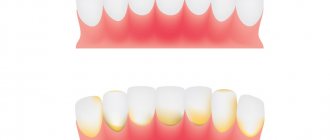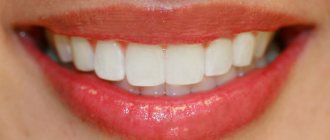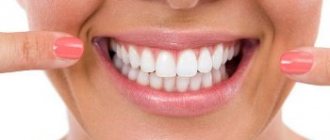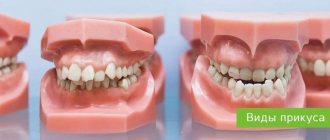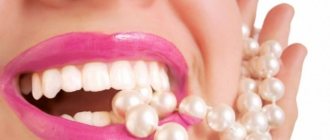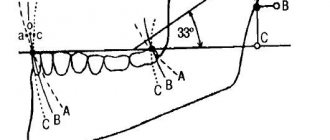The presence of a correct bite in an ordinary person is quite rare. Only 10-15% of people can demonstrate it before undergoing correction. Due to poor nutrition, lack of proper hygienic care, unsystematic dental care and non-compliance with the rules for the formation of the dentition, anomalies are very common.
The desire to have a beautiful smile is dictated not only by aesthetic requirements. It is one of the most important conditions that guarantee the longevity of permanent teeth and their health.
What is
A bite is a principle diagram of the closure of the upper and lower dentition in a relaxed state of the jaw, that is, when it is produced without excessive force.
Correct bite has a special name that is used in dentistry - physiological. There are several of its varieties, but they are all grouped according to one characteristic: these types do not provoke violations.
Prevention
In order for people to be able to boast of their smile and perfectly positioned teeth as adults, they need to start taking preventive measures in infancy:
- Every woman during pregnancy should protect herself from all kinds of infections. It is necessary to take vitamin and mineral complexes and eat right.
- Mothers should ensure their children receive constant breastfeeding. In this case, children will have much less problems with teeth.
- Babies need to choose the right pacifier. If he is bottle-fed or is given juices from a bottle, then you should not make too large a hole in the nipple.
- Mothers should ensure that the child does not suck his finger, as this habit can lead to the development of deformation processes.
- If your baby is already teething, he should be introduced to solid food.
- It is recommended to carry out myogymnastics with children, which involves performing a number of exercises that contribute to the formation of an ideal bite.
Kinds
The main characteristic of a correct bite is the central occlusion (closing) of both jaws.
Based on the analysis of the nature of closure, five main types of physiological occlusion were derived, which differ slightly from each other:
- Orthognathic . In orthodontics, this type is considered close to ideal. The main characteristic is that the top row, when closed, leaves 2/3 of the bottom row in the visible zone. They also pay attention to the density of contact: ideally, the surfaces fit tightly to each other, and there are no gaps between the cutters. With this type, the load on the temporomandibular joint is distributed evenly.
- Progenic. It is determined by a slight protrusion of the lower jaw forward. But, since this extension is weakly expressed, the closure is not disturbed, and the load on the jaw joint remains uniform.
- Straight . With this type, the dental arches close together with their cutting surfaces, without overlapping each other. This variety is correct, but has one drawback - high jaw abrasion. This phenomenon is observed due to the pronounced load on the cutting surfaces.
- Biprognathic . Both arches move slightly towards the lips, but the closure remains normal.
- Opisthognathic. Slight displacement of the arches into the oral cavity. At the same time, the teeth look perfectly straight from the outside.
Types of correct bite according to Angle's classification
In an adult
Due to the fact that the correct structure of the jaws begins to form during the process of intrauterine development, it is the expectant mothers who directly depend on what the bite of their children will be.
If, starting from infancy, parents do not pay due attention to their children’s teeth, then as they grow up, they will face many problems.
How is it determined
Correct bite is a complex concept, so several factors are compared to determine it:
- Shape of dental arches. As a standard, the upper teeth protrude slightly towards the lips, so the outer contour should always be larger than the inner. The lower jaw is built differently: its elements are slightly inclined towards the inside of the oral cavity.
- Symmetry of the face in the central part. With normal closure of the upper and lower arches, the correct proportions of the face are maintained and the main lines are observed.
- Coincidence of the midline of the face with the contact point of the anterior incisors. If there is a mismatch, an imperfection of the bite is visually detected, which is often visible even with the lips closed: the most prominent part above the upper lip is shifted to the right or left.
- No gaps between teeth. The elements of the dentofacial row should close tightly, leaving no significant gaps or gaps. In this case, the closure should not cause excessive friction.
- Antagonist contact. Antagonist teeth in the closed state of the jaws should contact each other, and not with neighboring elements. A slight overlap is possible, but if the antagonist is in contact with another element, there is a clear disproportion.
Using these principles, you can even determine whether a person has the correct bite on your own, but for a full diagnosis you should consult with an orthodontist.
Why is it important that occlusion is correct?
Incorrect occlusion creates a lot of problems for a person.
- Chewing function is impaired. Poorly chewed food, entering the digestive tract, causes disturbances in all its departments.
- Damage and abrasion of dental elements and injury to the soft tissues of the oral cavity may also occur.
- In addition to organic problems, improper occlusion develops psychological disorders in a person. Typically, the jaw looks unattractive and disrupts the symmetry of the face. A smile looks ugly. Problems appear with the pronunciation of sounds. All this forms complexes and develops self-doubt.
A photo of a side view before and after correction of pathological bites clearly demonstrates how much a person’s face changes after correction.
Why is it needed?
In addition to external aesthetics, a correct bite is necessary for the following reasons:
- Stable psychological state. One’s own physical defects are perceived exaggeratedly and have a negative impact on one’s state of mind and self-esteem, especially if there has been ridicule. The impact of such discomfort on building friendships, personal and business relationships is very powerful.
- The presence of a physiological dental arch eliminates an extensive list of diseases and health problems caused by incorrect dentition, such as displacement of the cervical vertebrae, impaired blood circulation in the brain, poor breathing during sleep, indigestion, headaches, etc.
- When the jaws close incorrectly, dental pathologies inevitably arise, such as abrasion and damage to the enamel, loosening and loss of individual elements, inflammation of the temporomandibular joint, etc.
Results
Such a concept as correct bite includes a number of features and characteristics, based on which one can determine the degree of deviation from the norm in the development of the masticatory system. There are a small number of anatomical and physiological indicators that signal whether a person has formed the correct bite or not.
Bringing clarity to this issue is very important, since an incorrect bite seen and corrected at the wrong time can cause a number of troubles and even provoke the occurrence of serious diseases. Changes to your bite are best done at an early age.
Modern orthodontists have a large arsenal of tools and design mechanisms and accessories available that can eliminate this problem. Correct bite also helps to normalize the psychological state and helps increase self-esteem.
If this article was interesting for you and “shed light” on the problem of bite formation and correction, you can share it with relatives, work colleagues and friends. I hope you learned something new and interesting on this topic and were able to find answers to your questions! Check out other materials on our blog, there is a lot of educational stuff there. Have a great day and stay safe!
When is formed
The dentist will be able to give a final conclusion regarding the correct or incorrect bite only after the baby teeth have been replaced with permanent ones, although recommendations for the formation of a correct bite are relevant long before this moment.
Before the age of 6 years, dentists should periodically examine the dentofacial apparatus. At the slightest deviation from the norm, after consultation, parents will receive advice aimed at stabilizing the situation. The sooner these corrective actions are implemented, the faster a good result can be achieved. With age, the rate of restoration of correct bite decreases, but it can be achieved at any age.
The formation is influenced by both hereditary and external factors. All stages of development are completed by the age of 15.
Important points for the development of correct bite are:
- breastfeeding for at least six months;
- exclusion of pacifiers and other breast substitutes;
- preventing the development of bad habits such as thumb sucking or other objects;
- physiological position during sleep without tilting the head back;
- normal amount of solid food in the diet.
Ways to correct a bite
Treatment of pathological occlusion is prescribed by an orthodontic doctor. You need to contact him as early as possible, since it is much easier to restore the normal position of teeth in childhood. The correction method depends on the age, type of pathology, and individual characteristics of the patient.
The following types of treatment are used:
- 1. Trainers, orthodontic plates and other devices for children. They allow you to set the correct growth of teeth, promote adequate development of the jaws and muscle frame.
- 2. Bracket systems. Fixed structures that are used only for permanent teeth. Helps move teeth in the right direction.
- 3. Aligners. Removable structures, which are transparent mouth guards. Bite correction occurs by gently shifting teeth when changing from one set of trays to another.
- 4. Surgical treatment. It is used when there is no effectiveness from conservative methods.
Our clinic uses only proven bite correction technologies. Doctors use high-quality and durable braces, aligners from well-known manufacturers, comfortable trainers and other devices.
Diagnostics
The physiology of the dentition is determined visually by the orthodontist, but in some cases additional examination may be necessary. It includes several stages:
- X-ray of the jaws - orthopantogram to assess the condition of the jaw system;
- an impression of the surface of the dental arches on a piece of copy paper;
- casts for creating a three-dimensional model in the laboratory;
- Close-up photographs of the face and smile to assess symmetry;
- consultations with doctors of other specialties, etc.
This set of diagnostic measures will determine whether the patient’s bite is correct or whether it needs correction.
Features of treatment
About thirty years ago, only children and teenagers under 16 years old could count on correction of pathology.
Thanks to the active introduction of new technologies in the dental field, today people of different age groups can have an ideal smile.
To correct defects, innovative brace systems are used, which exert physical pressure on the deformed jaw over a fairly long period of time.
In the most difficult situations, dentists resort to prosthetics, as well as various types of surgical interventions.
Network of dental clinics KANO and physical therapy clinic KANO
The human body is an inexpressibly complex system. Everything is closely intertwined in it, even if the relationship does not seem obvious at first glance. Therefore, qualified treatment and recovery require an integrated approach from thinking doctors of different specialties. Such a unique concept can be found in Minsk in the KANO network of dental clinics and the KANO physical rehabilitation clinic.
Dentists of the KANO clinic network will provide comprehensive treatment for dental problems of any complexity: from professional oral hygiene to high-tech digital prosthetics and Zygoma zygomatic implantation.
Physical Therapy Clinic KANO
And at the KANO physical therapy clinic, specialists will offer you a comprehensive program for posture correction and joint rehabilitation, which includes physical therapy and therapeutic exercises, physiotherapy, kinesiotherapy and massage. A holistic approach brings full results!
The importance of availability
Before talking about the importance for a person of having a correct bite, you should understand what it is. Another name for it is physiological. In this case, the shape, proportions and arrangement of both jaws and dentition are natural .
With a correct bite, the following is ensured:
- correctness of the features of the lower part of the face and head;
- absence of speech and chewing disorders;
- health of periodontal tissues and teeth;
- normal functioning of the entire dental system.
